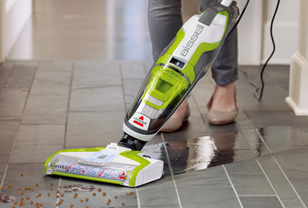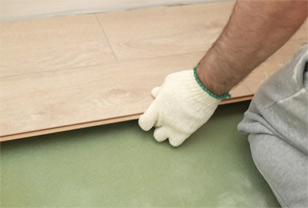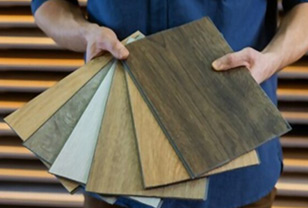How to Use a Pressure Washer to Clean Your Home
Pressure washers blast off dirt, grime or grease from surfaces and they use less water. As such, they’re water-efficient and very effective at cleaning various surfaces. But you might not know how to use a pressure washer properly. In this guide, we’re going to take you through the basics of using a pressure washer. Read on for more information.
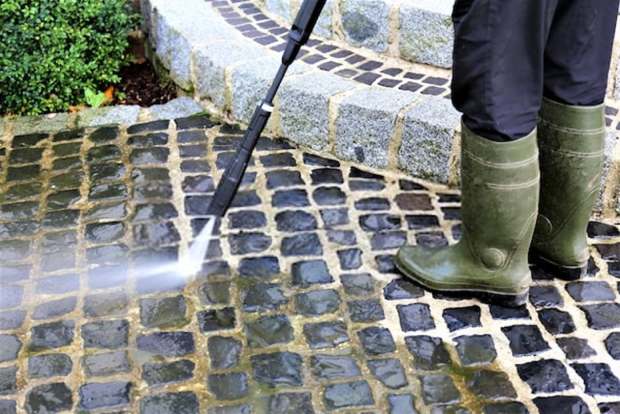
A photo of a pressure being used to clean a home
What are the two types of pressure washers?
Before looking at how to use a pressure washer, let’s increase our knowledge of them. There are two types of pressure washers — electric powered pressure washers and gas powered pressure washers. As you can deduce from their names, electric pressure washers use electric energy to run while gas pressure units use gasoline to run.
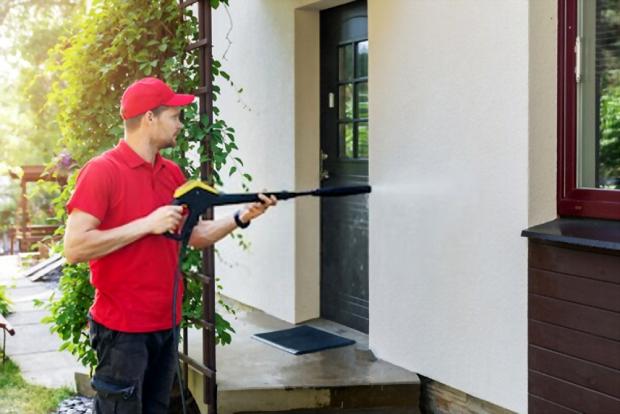
A close up picture of someone washing his house using a pressure washer
Gas pressure washers are suitable for heavy-duty cleaning operations. While electric pressure washers are ideal for light to medium-duty cleaning operations. You will need to assess your cleaning needs. If you want to clean a smaller surface, electric pressure washers are your best option.
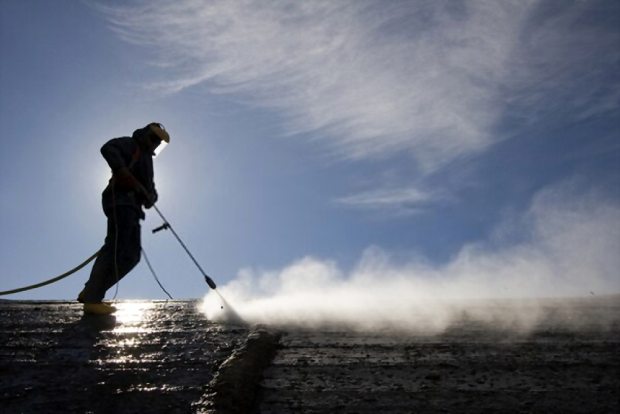
A picture showing how a pressure washer cleans the house
But for thorough cleaning or dealing with a much larger cleaning surface, gas pressure washers will be the way to go. Now that we’ve cleared the air, we are ready to dive deeper into how to use a pressure washer.
➜ RELATED: How to Pressure Wash a House: Detailed Instructions to Bring Back Its Clean Look
How should you use an electric pressure washer?
Safety comes first when using any machine. And a pressure washer is no exception! Make sure to wear protective eye gear. And if you’re using chemicals to clean various surfaces, wear a pair of gloves to protect you from skin irritation or other hazards.
1. Electric pressure washers
Let’s start off by looking at how to use an electric pressure washer. To use your electric pressure washer, follow the simple steps below:
● Set up the electric pressure washer
Electric pressure washers are quieter than gas pressure washers. They run using brushless motors, which aren’t as noisy as the gas engines that power gas pressure washers. As such, you might not need any protection for your ears. But eye protection gear is still necessary for this step.
Plug the unit into the mains power outlet. They usually come with a 12 or 14 foot power extension cord. Make sure the power outlet has a GFCI — Ground Fault Circuit Interrupter — protection to prevent any electrical hazards. But don’t turn on the power just yet.
● Connect the electric pressure washer to a water supply
Pressure washers need water supply to work. If you don’t connect them to a water supply and turn on the unit, you will damage the motor and the pump. And, obviously, this is not good! Usually, electric pressure washers need water inlet in the range of 1-1.5 GPM (gallons per minute).
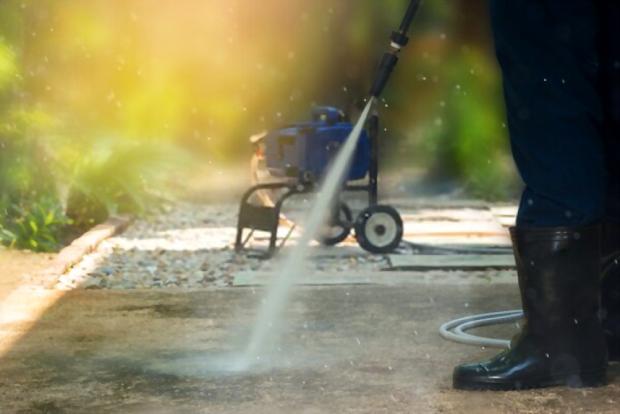
A close up picture of someone cleaning his pathway using a pressure washer
Make sure the water source can supply the machine with water at that flow rate. Otherwise, your pressure washer might not work efficiently or be damaged during operation. Be sure to check the GPM of the water inlet you will use before connecting the washer to a water supply.
You should connect the water source to the electric pressure washer with a garden hose. Lay the garden hose down on the ground and make sure it has no obstacles impeding water flow which can affect the pressure of the water supply.
● Check the water inlet temperature
Besides checking the inlet water pressure, also check its temperature. Normally, electric pressure washers need their inlet water to have a temperature of 140° F. This will guarantee the optimal operation of all the components of the electric pressure washer.
Higher temperatures will damage the pump of the unit or the motor. Electric pressure washers have a pump that produces a high-pressure jet for cleaning various surfaces. But some pumps can handle hot water inlets. As such, make sure you know the temperature range the pump can handle during a cleaning operation.
● Rinse out the garden hose for a few seconds
Before connecting a garden hose to the electric pressure washer, connect it to the water supply and let the water run through it for 30 seconds to 1 minute. This is to flush out any dirt or debris in the garden hose. Dirt and other solid particles aren’t good for the internal components of your electric pressure washer.
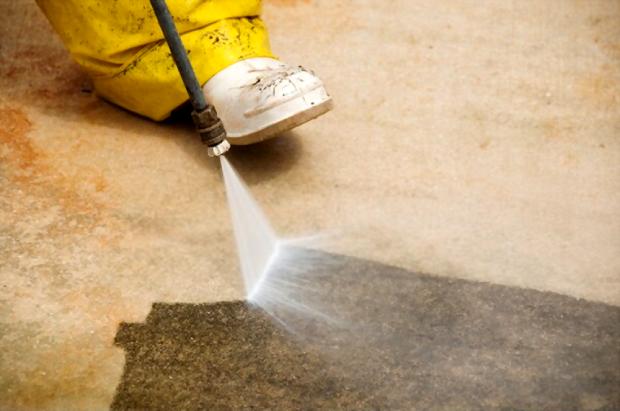
Someone cleaning his driveway using a pressure washer
Once you have flushed out dirt and other debris, turn off the water supply. Then connect the other end of the garden hose to the water inlet port on the electric pressure washer. Locating the water inlet port on the machine should be an easy task.
Most electric pressure washers have a blue plastic valve on them or have a labeled water inlet port. Screw the threading of your garden hose into the port until the set-up is tight enough. For an excellent connection with a hose, make sure the hose’s diameter matches that of the water inlet port on the machine. Consult the washer’s user manual for more information on this.
➜ RELATED: Ryobi 1600 Psi Pressure Washer: Compact But Powerful Pressure Washer For Residential Use
● Connect one end of the high-pressure hose to the machine
At this point, you have successfully connected the washer to a water supply with a garden hose. You have also ensured that the garden hose is free from dirt and other particles. Now, it is time for another crucial connection. The high-pressure hose comes with the electric pressure washer during a purchase. Even if you have rented an electric pressure washer, it will come with this crucial component.
The pump outlet is usually close to the water inlet port on the electric pressure washer. Connect (feed) one end of the black high-pressure hose to the pump outlet.
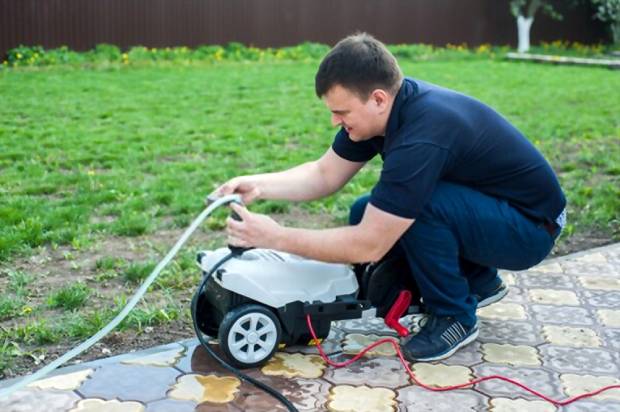
A pressure washer connected to a machine
Simply pull back the valve on the outlet and put one end of the high-pressure hose in place then release the valve. After releasing the pump outlet valve, you should have a firm connection, which is perfect! Remember to always use the machine’s high-pressure hose to make this kind of connection. Any other hose will burst, especially a garden hose.
They cannot handle the pressure that the washer’s pump will be generating. High-pressure hoses are usually black. In case your washer didn’t come with one, buying another high-pressure hose is the only option you have left. And make sure it is for the electric pressure washer model that you intend to use.
● Connect the other end of the high-pressure washer
Now, you might be wondering: “where is the other end of the high-pressure hose going to be?” The answer is the spraying gun! Yes, you’ve heard it right. Otherwise, where would the other end go? The spray gun has a port on its bottom. It is through that port that the other end of the high-pressure hose is going to go.
And connecting this other end to the spray gun is easy as pie. You could simply screw that end into the valve on the spray gun or pull back the valve to snap the high-pressure hose in place, depending on the model.
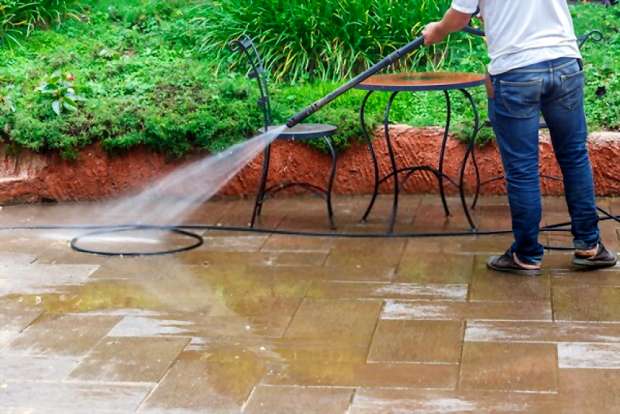
A close up picture showing a man cleaning his compound
Make sure the hose and the spray gun have a tight connection to prevent any water leaks. You want to do this to make sure that the water pressure from the pump doesn’t go to waste in the form of a water leak.
The high-pressure hose doesn’t necessarily go into the bottom of a spray gun. Sometimes, it may go to the end of the spray gun. It all depends on the electric pressure washer model or the design you’re working with.
● Select a spray nozzle and snap it in place
The spray gun has a wand that needs a spray nozzle to direct the water jet accordingly. This means the spray nozzles are important and need to be connected to the spray gun wand for optimal cleaning performance. If you buy an electric pressure washer, you will get 0°, 15°, 25°, 40°, and 65° nozzles.
Each nozzle has a specific function. And they’re color-coded for easy identification. The colors are coded as follows: 0°- red, 15°- yellow, 25°- green, 40°- white and 65°- black. The black nozzle produces a jet that blasts off grime or dirt on strong solid surfaces such as metals and concrete.
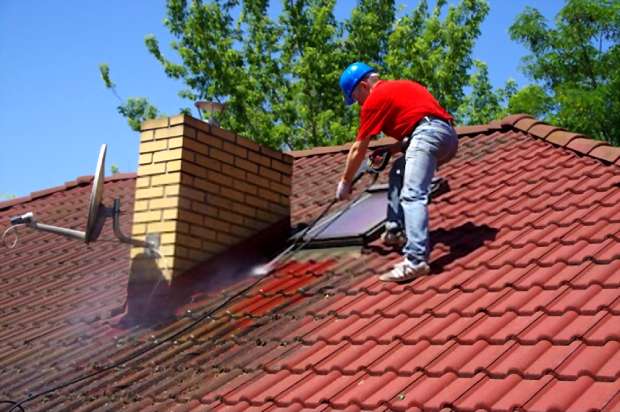
A close picture of a man cleaning his roof using a pressure washer
If you’re looking to clean a driveway or some gutters, you would want to select the yellow nozzle. But for cleaning wooden decks and vehicles, the green nozzle will do an excellent job. It produces enough pressure to blast off dirt and debris.
The white nozzle with a 40° spraying angle works great for house siding and stucco. So, if you’re looking to find out how to pressure wash a house, now you have it! Sometimes, you will need to use a detergent to clean some surfaces, especially when cleaning your car. During such times, the black nozzle with a 65° spraying pattern will be a perfect choice.
Snapping the appropriate nozzle into place on the wand is also an easy task. Simply push the nozzle in the port on the wand and you will be good to go. Or you can also twist or tug the nozzle in place.
● Arm your electric pressure washer with a detergent
If you want extra cleaning strength, you will have to add detergent to the unit. But the question remains: “how do you add detergent to an electric pressure washer?” The answer is very simple.
Electric pressure washers either have a compartment for detergent on them or have an on-board detergent tank on the spraying gun. You will add an all-purpose detergent to this compartment or the tank, depending on the model you’re working with. The cleaning detergent works best with low-pressure nozzles, which in this case would be the black nozzle.
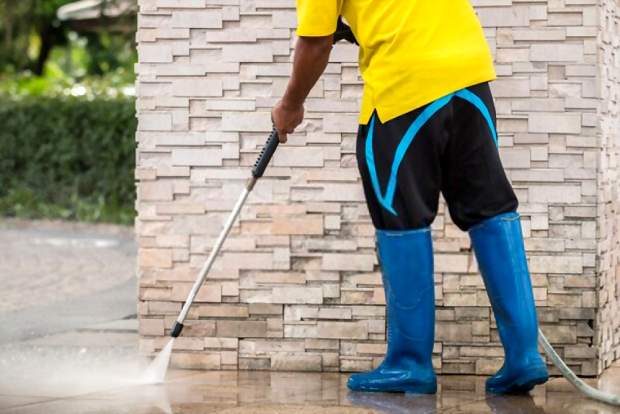
A picture showing someone cleaning his outdoors using a pressure washer
But sometimes, your electric pressure washer might not have a detergent tank. In this situation, what will you do? That's a good question. You can pour the cleaning detergent into a bucket. Make sure the bucket has a reasonable size. Run a hose from the bucket containing the detergent solution to the detergent hookup port.
Your pressure washer has a mechanism for drawing the detergent from the bucket using the hose. Again, it becomes necessary to choose a hose whose size will fit through the detergent hookup port on the electric pressure washer or the spray gun. The machine might not draw the detergent efficiently if you choose the wrong hose size.
● Turn on the water supply
At this point, you have successfully connected all the vital components of the electric pressure washer to each other. The only thing keeping you from starting the cleaning operation is the water supply and power, which is still switched off.
Simply turn on the water supply to let water flow into the machine. The water should be within the acceptable pressure (GPM) and temperature.
Once water is running through the garden hose into the machine, go to the main power outlet and switch the power on. For cordless electric pressure washers, you don’t have to worry about switching any power outlet on.
● Pull the trigger on the spray gun
If you are wondering how to start a pressure washer, simply engage the trigger. Only engage the trigger after you have connected your washer to a power outlet and switched on the power. Otherwise, you will not get any jet for cleaning a surface.
Most electric pressure washers will start to eject a high-pressure jet the moment you pull the trigger. And they stop if you disengage the trigger.
This gives you control over the cleaning operation with just a finger. Since the water jet automatically stops if you release the trigger, the pump will last longer.
For cordless (battery-powered) electric pressure washers, you might need to switch the unit on before pressing or pulling the trigger. Generally, electric pressure washers are easy to use. They provide cleaning pressure that ranges from 1,300-1,400 PSI (Pound per Square Inch). As such, they’re ideal for cleaning around the home.
Corded washers run longer than their cordless counterparts. That's because they use a more stable power source . They're best if you’re looking for a quiet but longer running time. However, they’re less portable. If you want more portability but are okay with a limited runtime, cordless electric pressure washers will be the best option when it comes to electric units.
How to clean using an electric pressure washer
You should make sure you are selecting the right nozzle depending on the nature of the surface you’re looking to clean. Hold the spray gun so the nozzle is 1-2 feet from the surface at a 45° angle. Press the trigger to get a jet with the right pressure.
Holding the spray gun so that the nozzle is too close to the ground might cause damage. The nozzle doesn’t alter the pressure of the jet that much. It only alters the size of the jet, hence affecting the area of spray with a single sweep.
When cleaning house sidings, be sure to use wand extensions for higher places. When cleaning high places, it might be tempting to climb a ladder. Don’t climb any ladder while operating a pressure washer since pressure washers generate a kickback force when producing a high-pressure jet through the nozzle.
As a result, you might fall off the ladder or fall with it. Also, be sure to read the user manual before using the washer. The manual will tell you the dos and don’ts.
How should you turn off the washer?
After you have achieved the cleaning outcome that’s gonna be the envy of the entire neighbourhood, the next necessary step is turning off the washer for storage. But how do you turn it off and store it? First, release the trigger and turn on the safety lock. You can set the nozzle of the washer on the ground now.
Turn off the water supply. At this point, there is still a huge pressure build-up in your electric pressure washer. You want to let off this unnecessary pressure. So, without detaching the garden hose from either the water supply or the washer, turn off the safety lock and engage the trigger.
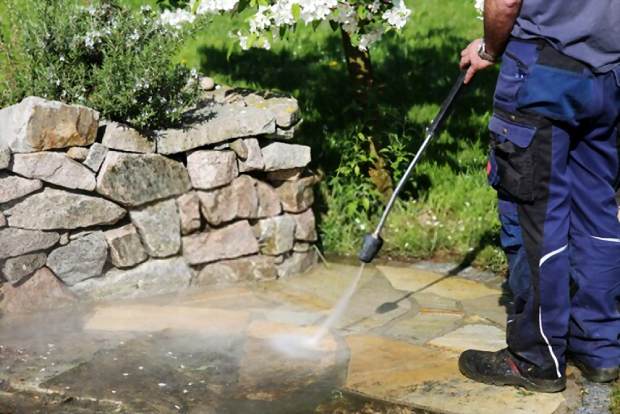
A close up picture showing someone cleaning his house with a higher pressure washer
Press the trigger until water cease to come out of the nozzle. This should take you 1 minute at most. Once the pressure has subsided, disengage the trigger and turn on the safety lock. Go to the power outlet and switch off the power. For cordless electric pressure washers, switch the machine off.
Detach the garden hose from the washer and water supply. You can choose to leave the other end of the garden hose to the water supply. Also, detach the high-pressure hose from the pump’s outlet port and the spray gun inlet port.
Wrap the power cord on the cord hook if your unit has one. Also, wrap the high-pressure hose and store it away, together with the washer. Make sure you have safely kept all the nozzles for use during your next cleaning sessions.
Where can you get an electric pressure washer?
You can either buy or rent an electric pressure washer from your local home improvement store. For renting such a machine, you might spend anything between $50-$100. You can also decide and buy an electric pressure washer for $100-$200.
If you need to do some thorough outdoor cleaning just once a year, renting an electric power washer is an ideal option. But for continuous cleaning operations, buying a washer is the best option. This will save you money in the long run.
For optimum cleaning operations, you should choose the best pressure washer on the market. Now that you know how to operate a pressure washer. You should take action and blast off dirt and grime from various surfaces in your home.
2. Gas pressure washers
Another type of pressure washer is the gas pressure washers. This type of pressure washer uses a gasoline engine to run. That means gas is the main power source. They're louder and obviously produce emissions that may be harmful to the environment or yourself, if you are working in an enclosed space. In short, they don’t run on clean energy.
But they are the most powerful pressure washers. And the most expensive as well. They're great for heavy-duty cleaning operations since they blast off dirt, dust, grime or stains with very powerful jets. They generate between 3,000 and 4,000 PSI — Pounds per Square Inch.
They cost between $300-$600. So, how do you use gas pressure washers? Read on to find how to start a gas pressure washer. Follow the steps below:
● Set up the gas pressure washer
You want to make sure you have sufficient fuel in the fuel tank, and sufficient oil in the oil tank. In case these two fluids are low, you will need to refill them. Start with the fuel tank. Unscrew the fuel tank cap and pour unleaded gasoline in the fuel tank until the tank is full.
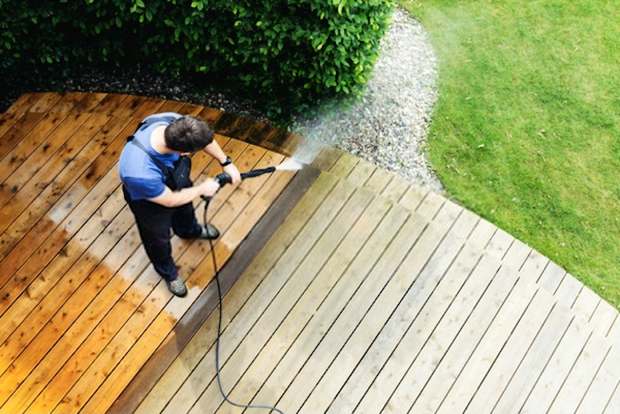
A detailed picture showing someone cleaning his compound using a pressure washer
Then do the same with the oil reservoir. Make sure you’re pouring the recommended oil in the oil reservoir until it reaches the desired fill level on the dipstick. Before adding any of these two fluids, consult the user manual to make sure you are adding the recommended gas and motor oil.
● Connect the high-pressure hose to the washer and spray gun
You want to connect one end of the high-pressure washer to the pump outlet on the machine. This is something that you can do with ease. A high-pressure hose has a male end. That is the end that you will connect to the water outlet (pump outlet) on the gas pressure washer.
Make sure that you have a tight and firm connection. You want to make sure there are no water leaks during a cleaning operation. A water leak not only alters the cleaning results but wastes water as well. Once you have connected the male end of the high-pressure hose into the pump outlet, connect the other end of the high-pressure hose to the spray gun.
Your gas pressure washer will have a spray gun with a plug at the bottom of its assembly. Simply slide the other end of the high-pressure hose into this plug. Again, make sure you have a tight connection. Don’t leave any room for water leaks.
High-pressure hoses can withstand the pressure build-up within them. That makes them the only type of hose to be used with a pressure washer spray gun. Always use a high-pressure hose that’s recommended for the gas pressure washer model that you’re using to clean. In case you don’t have this hose, buy one from your local home improvement store.
● Choose the appropriate nozzle
The spray gun of your gas pressure washer has a wand. At the end of this wand, you will need to attach a nozzle. Pressure washers come with 4-5 nozzles. The nozzles are color-coded and provide a spray pattern that is suitable for blasting off particular stains, grease or dirt.
The nozzles are as follows: 0° (Red), 15° (Yellow), 25° (Green), 40° (White), and 60° (Black). Each nozzle is suitable for a specific cleaning result. The red nozzle has the highest power. As a result, it is suitable for blasting off dirt, grime, oil, and grease from hard surfaces such as concrete and metal surfaces.
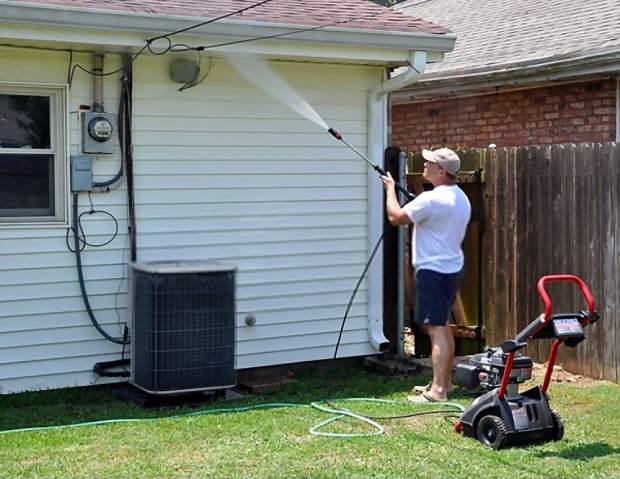
A picture showing a man using a pressure washer
Also, you can strip your house sidings for fresh paint, or clean your wooden deck by using a pressure washer. Gas pressure washers do a marvelous job in this case. All you need to do is place the yellow nozzle at the end of the spray gun wand.
If you want to clean dirt and debris from cars, concrete floors, driveways or boats, the green nozzle will be of great service. The white nozzle is for more fragile surfaces like the windows, or surfaces that easily get a dent from slight pressures.
If you desire to apply soap to a surface that you’re cleaning, use the black nozzle. It applies the soap in a larger area if you compare it with other nozzles. As such, it is the best nozzle for applying a cleaning detergent.
● Connect the gas pressure to a water supply
A garden hose will come in handy in this situation. Make sure the garden hose size is the recommended one for a perfect connection. A hose with quick-connectors will be what you need in this case. So, connect one end of the garden hose to a water supply.
Turn on the water supply and let the water run through the hose for 30 seconds to 1 minute. This exercise is to make sure there is no dirt or solid particles inside the garden hose. Such solids will damage the gas pressure washer pump and other internal components.
Connect the other end of the garden hose to the pump inlet on the gas pressure washer. Use the quick connectors to make this connection. Make sure the connected garden hose is tight enough to prevent any water leaks. You can turn on the water supply. Make sure the water supply is feeding the gas pressure washer with water at 2-3 GPM.
Gas pressure washers need more water to clean than their electric counterparts. Remember that they are ideal for heavy-duty cleaning operations. So, they need more water. Also, check the inlet water temperature. Most gas pressure washers will need their inlet water to have a temperature of 140°F. But some can handle hot water inlets.
Again, consult your user manual for more information on the acceptable inlet water temperatures. Once everything checks out, open the faucet.
● Connect soap applicator
Gas pressure washers come with a soap applicator for extra cleaning strength. Some models have their soap applicators on-board while some have a spray gun with an onboard detergent tank.
You should fill the detergent reservoir with an all-purpose soap for you to have extra cleaning strength. If you are having trouble locating where to connect the detergent tank, always read the user manual for more information.
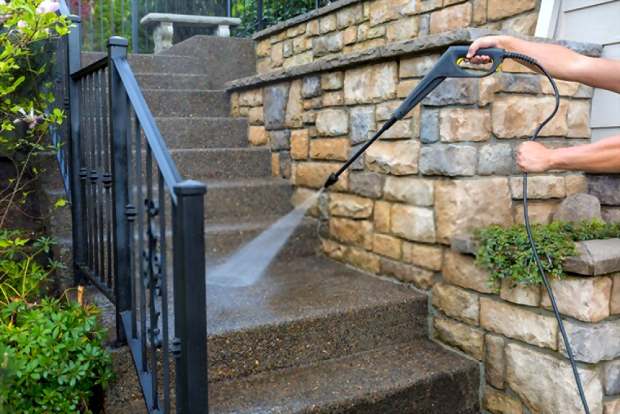
A close up picture showing someone cleaning his stairs using a pressure washer
If you lost your detergent tank, you can pour the detergent solution in a reasonably-sized bucket and run a hose from the bucket to the hookup port of the detergent tank. Your gas pressure washer will draw the cleaning solution during soap application on to a surface.
But always buy a soap applicator or detergent tank if you are missing yours. They're very inexpensive and will save you the hassle of assembling the various components of a gas pressure washer.
● Switch on the water faucet or water supply
At this point, you have made the necessary connections. It is now time to switch on the gas pressure washer. You should have already checked the gas and oil levels and made sure they’re okay. And if they were not okay, you had already added them to their respective tanks.
There might be air trapped within the pressure washer and you want to purge the washer for any excess air. Press the trigger on the spray gun for the excess air to release from the nozzle. Do this before starting the engine of the pressure washer.
First, you want to make sure that the fuel valve of the washer is in the open position. Then move the choke to the open position as well. Move the throttle to full throttle position. Turn the engine switch on.
Hold the spray gun in such a way that the nozzle is in a safe position. Then squeeze the trigger. Pull the coil to start the engine. Once the engine has started running, close the choke. Now you are ready to take on any surface and clean it with sufficient cleaning pressure. That's how to start a gas pressure washer.
The nozzles let you adjust the pressure of the jet. Gas pressure washers provide washing pressure ranging from 2,000-4,000 PSI. That means you can always vary the pressure to meet your cleaning needs. For areas that need low pressure like the windows, you always have the option of reducing the pressure of the jet.
The nozzles let you regulate the pressure. Also, they let you alter the cleaning area per sweep of the wand. They provide a spraying pattern of various angles (degrees) for cleaning various areas of a surface.
Pressure washer cleaning tips
Gas pressure washers are louder. As such, you might need ear mufflers to protect your auditory system. Also, be sure to wear some eye protection gear. The spray-up from the high-pressure jet could cause serious eye injury if you don’t have any protective eyewear on.

A close up picture showing someone cleaning his home using a pressure washer
Besides, high-pressure jets can dislodge dirt, sending them flying into the air. You don’t want to be caught unaware during a high-power cleaning operation. Always take your protection very seriously. When cleaning a surface, especially soft ones, don’t hold the nozzle too close to the surface.
The high-pressure jet might cause dents, which is something no one wants. Also, don’t hold the spray gun so that the jet directly hits the surface. You want to hold the spray gun so that the jet hits the surface at a 45° angle.
This reduces the force with which the jet hits the surface thus reducing chances of getting dents. That's all you need to know if you’re looking to find out how to use a power washer. You can use these pressure washer tips for both electric and gas-powered units.
Switching off the gas pressure washer
Once you have completed the cleaning operation, you should switch off the pressure washer and put it away in a store-room. Begin by disengaging the trigger and turning the engine switch off. This will stop the engine. But there will still be a huge pressure build-up within the gas pressure washer.
After the engine is off, press the trigger again to let off excess pressure within the washer. Turn off the water faucet or water supply. Disconnect the high-pressure hose and garden hose. Make sure to return all the nozzles in their rightful place — nozzles holder on-board the pressure washer.
You can transport the gas pressure washer to the store-room. Since most of these units have a pair of wheels, moving them to a store-room should be an effortless activity.
Conclusion
Using a pressure washer or power washer can be as simple as using a garden hose to clean a surface. But you always need to be extra careful when handling any machine, including a pressure washer. Power washing tips are useful for your safety and for the people around you.
You might not know how to start assembling the different components of a pressure washer together. This guide has taken you through the basics, and you should be able to clean your indoor or outdoor space without hiring a professional cleaning company.
What now remains is either renting or buying a pressure washer and give your car, driveway, boat, wood decks or house powerful cleaning operation. If you usually clean once or twice a year, renting a pressure washer is just fine.
But for frequent cleaning operations, buying your own pressure washer will be the best option. Also, remember to buy electric pressure washers for light to medium-duty cleaning operations. And gas pressure washers for heavy-duty cleaning operations. Give your home a powerful cleaning that neighbors will envy.






